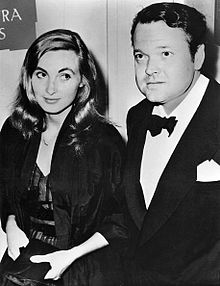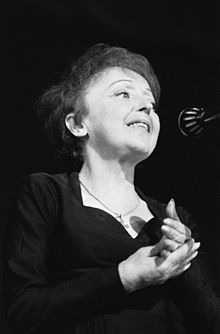 On this day in 1963, French singer and cultural icon Édith Piaf died of liver cancer at age 47 at her villa in Plascassier (Grasse), on the French Riviera, the day before filmmaker and friend Jean Cocteau died. Born Édith Giovanna Gassion on 19 December 1915 in Belleville, Paris. Widely regarded as France’s national diva, as well as being one of France’s greatest international stars. Her singing reflected her life, with her specialty being ballads. Among her songs are “La Vie en rose” (1946), “Non, je ne regrette rien” (1960), “Hymne à l’amour” (1949), “Milord” (1959), “La Foule” (1957), “l’Accordéoniste” (1955), and “Padam… Padam…” (1951). Reportedly, the love of Piaf’s life, the married boxer Marcel Cerdan, died in a plane crash in October 1949, while flying from Paris to New York City to meet Piaf. Cerdan’s Air France flight, flown on a Lockheed Constellation, crashed in the Azores, killing everyone on board, including noted violinist Ginette Neveu. Piaf and Cerdan’s affair made international headlines, as Cerdan was the former middleweight world champion and a legend in France in his own right. Piaf married Jacques Pills (1952 – 1957 divorce) and Théo Sarapo (1962 – 1963 her death).
On this day in 1963, French singer and cultural icon Édith Piaf died of liver cancer at age 47 at her villa in Plascassier (Grasse), on the French Riviera, the day before filmmaker and friend Jean Cocteau died. Born Édith Giovanna Gassion on 19 December 1915 in Belleville, Paris. Widely regarded as France’s national diva, as well as being one of France’s greatest international stars. Her singing reflected her life, with her specialty being ballads. Among her songs are “La Vie en rose” (1946), “Non, je ne regrette rien” (1960), “Hymne à l’amour” (1949), “Milord” (1959), “La Foule” (1957), “l’Accordéoniste” (1955), and “Padam… Padam…” (1951). Reportedly, the love of Piaf’s life, the married boxer Marcel Cerdan, died in a plane crash in October 1949, while flying from Paris to New York City to meet Piaf. Cerdan’s Air France flight, flown on a Lockheed Constellation, crashed in the Azores, killing everyone on board, including noted violinist Ginette Neveu. Piaf and Cerdan’s affair made international headlines, as Cerdan was the former middleweight world champion and a legend in France in his own right. Piaf married Jacques Pills (1952 – 1957 divorce) and Théo Sarapo (1962 – 1963 her death).
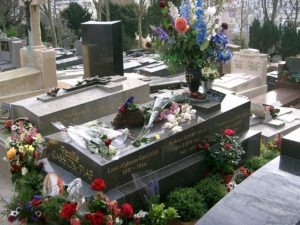 The Final Footprint – Apparently, her last words were “Every damn fool thing you do in this life, you pay for.” It is said that her body was driven back to Paris secretly so that fans would think she had died in her hometown. She is buried in Père Lachaise Cemetery in Paris next to her daughter Marcelle, where her grave is among the most visited. Although she was denied a funeral mass by the Roman Catholic archbishop of Paris because of her lifestyle, her funeral procession drew tens of thousands of mourners onto the streets of Paris and the ceremony at the cemetery was attended by more than 100,000 fans. Charles Aznavour recalled that Piaf’s funeral procession was the only time since the end of World War II that he saw Parisian traffic come to a complete stop. In Paris, a two-room museum is dedicated to her, the Musée Édith Piaf (5, Rue Crespin du Gast). La Vie en Rose (2007), a film about her life directed by Olivier Dahan, debuted at the Berlin Film Festival in February 2007. Titled La Môme in France, the film stars Marion Cotillard in the role that won her the Academy Award for Best Actress (Oscar), as Piaf. David Bret’s 1988 biography, Piaf, A Passionate Life, was re-released by JR Books to coincide with the film’s release. Piaf’s song “Non, je ne regrette rien” appears recurringly throughout the film Inception (2010), and Hans Zimmer reworked pieces of the song into cues of the score. Inception featured Leonardo DiCaprio as Cobb and Cotillard as Mal. Other notable Final Footprints at Père Lachaise include; Guillaume Apollinaire, Honoré de Balzac, Georges Bizet, Jean-Dominique Bauby, Maria Callas, Frédéric Chopin, Colette, Auguste Comte, Jean-Baptiste-Camille Corot, Max Ernst, Molière, Jim Morrison, Camille Pissarro, Marcel Proust, Sully Prudhomme, Gioachino Rossini, Georges-Pierre Seurat, Simone Signoret, Gertrude Stein, Dorothea Tanning, Alice B. Toklas, Oscar Wilde, and Richard Wright.
The Final Footprint – Apparently, her last words were “Every damn fool thing you do in this life, you pay for.” It is said that her body was driven back to Paris secretly so that fans would think she had died in her hometown. She is buried in Père Lachaise Cemetery in Paris next to her daughter Marcelle, where her grave is among the most visited. Although she was denied a funeral mass by the Roman Catholic archbishop of Paris because of her lifestyle, her funeral procession drew tens of thousands of mourners onto the streets of Paris and the ceremony at the cemetery was attended by more than 100,000 fans. Charles Aznavour recalled that Piaf’s funeral procession was the only time since the end of World War II that he saw Parisian traffic come to a complete stop. In Paris, a two-room museum is dedicated to her, the Musée Édith Piaf (5, Rue Crespin du Gast). La Vie en Rose (2007), a film about her life directed by Olivier Dahan, debuted at the Berlin Film Festival in February 2007. Titled La Môme in France, the film stars Marion Cotillard in the role that won her the Academy Award for Best Actress (Oscar), as Piaf. David Bret’s 1988 biography, Piaf, A Passionate Life, was re-released by JR Books to coincide with the film’s release. Piaf’s song “Non, je ne regrette rien” appears recurringly throughout the film Inception (2010), and Hans Zimmer reworked pieces of the song into cues of the score. Inception featured Leonardo DiCaprio as Cobb and Cotillard as Mal. Other notable Final Footprints at Père Lachaise include; Guillaume Apollinaire, Honoré de Balzac, Georges Bizet, Jean-Dominique Bauby, Maria Callas, Frédéric Chopin, Colette, Auguste Comte, Jean-Baptiste-Camille Corot, Max Ernst, Molière, Jim Morrison, Camille Pissarro, Marcel Proust, Sully Prudhomme, Gioachino Rossini, Georges-Pierre Seurat, Simone Signoret, Gertrude Stein, Dorothea Tanning, Alice B. Toklas, Oscar Wilde, and Richard Wright.
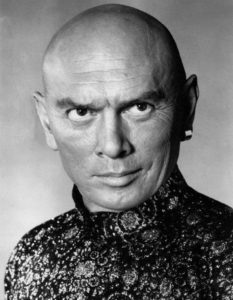 On this day in 1985, Oscar winning actor Yul Brynner died in New York City at the age of 65 from lung cancer. Born Yuliy Borisovich Bryner on 11 July 1920 in Vladivostok, Russia. Perhaps best known for his portrayal of the King of Siam in the Rodgers and Hammerstein musical The King and I, for which he won two Tony Awards and an Academy Award for the film version; he played the role 4,625 times on stage. He is also remembered as Rameses II in the 1956 Cecil B. DeMille blockbuster The Ten Commandments, General Bounine in the 1956 film Anastasia and Chris Adams in The Magnificent Seven. Brynner was noted for his distinctive voice and for his shaved head, which he maintained as a personal trademark long after adopting it in 1951 for his role in The King and I. Of course, my favorite movie he starred in is The Magnificent Seven (1960).
On this day in 1985, Oscar winning actor Yul Brynner died in New York City at the age of 65 from lung cancer. Born Yuliy Borisovich Bryner on 11 July 1920 in Vladivostok, Russia. Perhaps best known for his portrayal of the King of Siam in the Rodgers and Hammerstein musical The King and I, for which he won two Tony Awards and an Academy Award for the film version; he played the role 4,625 times on stage. He is also remembered as Rameses II in the 1956 Cecil B. DeMille blockbuster The Ten Commandments, General Bounine in the 1956 film Anastasia and Chris Adams in The Magnificent Seven. Brynner was noted for his distinctive voice and for his shaved head, which he maintained as a personal trademark long after adopting it in 1951 for his role in The King and I. Of course, my favorite movie he starred in is The Magnificent Seven (1960).
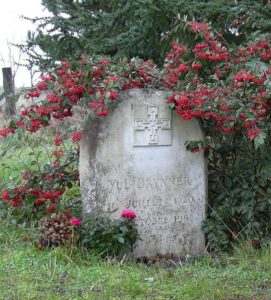 The Final Footprint – Brynner is buried on the grounds of the Saint-Michel-de-Bois-Aubry Russian Orthodox monastery, not far from Luze, between Tours and Poitiers, Vienne, France.
The Final Footprint – Brynner is buried on the grounds of the Saint-Michel-de-Bois-Aubry Russian Orthodox monastery, not far from Luze, between Tours and Poitiers, Vienne, France.
His grave is marked with an upright stone marker with his name and birth and death dates.
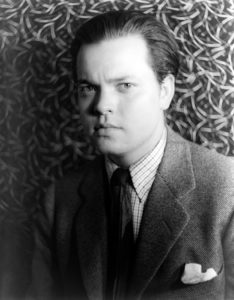 On this day in 1985, actor, director, writer, and producer, Orson Welles died from a heart attack at his home in Hollywood at the age of 70. Born George Orson Welles on May 6, 1915 in Welles worked in theatre, radio, and film. He is remembered for his innovative work in all three: in theatre, most notably Caesar (1937), a Broadway adaptation of William Shakespeare’s Julius Caesar; in radio, the legendary 1938 broadcast “The War of the Worlds”; and in film, Citizen Kane (1941), consistently ranked as one of the greatest films ever made.
On this day in 1985, actor, director, writer, and producer, Orson Welles died from a heart attack at his home in Hollywood at the age of 70. Born George Orson Welles on May 6, 1915 in Welles worked in theatre, radio, and film. He is remembered for his innovative work in all three: in theatre, most notably Caesar (1937), a Broadway adaptation of William Shakespeare’s Julius Caesar; in radio, the legendary 1938 broadcast “The War of the Worlds”; and in film, Citizen Kane (1941), consistently ranked as one of the greatest films ever made.
In his 20s, Welles directed a number of high-profile stage productions for the Federal Theatre Project, including an adaptation of Macbeth with an entirely African American cast, and the political musical The Cradle Will Rock. In 1937 he and John Houseman founded the Mercury Theatre, an independent repertory theatre company that presented a series of productions on Broadway through 1941. Welles found national and international fame as the director and narrator of a 1938 radio adaptation of H. G. Wells’ novel The War of the Worlds performed for his radio anthology series The Mercury Theatre on the Air. It reportedly caused widespread panic when listeners thought that an invasion by extraterrestrial beings was actually occurring.
His first film was Citizen Kane (1941), which he co-wrote, produced, directed, and starred in as Charles Foster Kane. Welles was an outsider to the studio system and directed only 13 full-length films in his career. He struggled for creative control on his projects early on with the major film studios and later in life with a variety of independent financiers, and his films were either heavily edited or remained unreleased. His distinctive directorial style featured layered and nonlinear narrative forms, uses of lighting such as chiaroscuro, unusual camera angles, sound techniques borrowed from radio, deep focus shots, and long takes.
Welles followed up Citizen Kane with 12 other feature films, the most acclaimed of which include The Magnificent Ambersons (1942), Touch of Evil (1958), and Chimes at Midnight (1966). Other works of his, such as The Lady from Shanghai (1947) and F for Fake (1973), are also well-regarded.
Welles and Chicago-born actress and socialite Virginia Nicolson (1916–1996) were married on November 14, 1934. The couple separated in December 1939 and were divorced on February 1, 1940. After bearing with Welles’s romances in New York, Virginia had learned that Welles had fallen in love with Mexican actress Dolores del Río.
Infatuated with her since adolescence, Welles met del Río at Darryl Zanuck’s ranch soon after he moved to Hollywood in 1939. Their relationship was kept secret until 1941, when del Río filed for divorce from her second husband. They openly appeared together in New York while Welles was directing the Mercury stage production Native Son. They acted together in the movie Journey into Fear (1943). Their relationship came to an end due, among other things, to Welles’s infidelities. Del Río returned to México in 1943, shortly before Welles married Rita Hayworth.
Welles married Hayworth on September 7, 1943. They were divorced on November 10, 1947. During his last interview, recorded for The Merv Griffin Show on the evening before his death, Welles called Hayworth “one of the dearest and sweetest women that ever lived … and we were a long time together—I was lucky enough to have been with her longer than any of the other men in her life.”
In 1955, Welles married actress Paola Mori (née Countess Paola di Girifalco), an Italian aristocrat who starred as Raina Arkadin in his 1955 film, Mr. Arkadin. The couple began a passionate affair, and they were married at her parents’ insistence. They were wed in London May 8, 1955.
Croatian-born artist and actress Oja Kodar became Welles’s longtime companion both personally and professionally from 1966 onward, and they lived together for some of the last 20 years of his life.
The Final Footprint
Welles was cremated. A brief private funeral was attended by Mori, Welles’s three daughters, and a few close friends.
A public memorial tribute took place November 2, 1985, at the Directors Guild of America Theater in Los Angeles.
“I know what his feelings were regarding his death”, Joseph Cotten later wrote. “He did not want a funeral; he wanted to be buried quietly in a little place in Spain. He wanted no memorial services …” Cotten declined to attend the memorial program; instead he sent a short message, ending with the last two lines of a Shakespeare sonnet that Welles had sent him on his most recent birthday:
But if the while I think on thee, dear friend,
All losses are restored and sorrows end.
In 1987 the ashes of Welles and Mori (killed in a 1986 car crash) were taken to Ronda, Spain, and buried in an old well covered by flowers on the rural estate of a longtime friend, bullfighter Antonio Ordóñez.
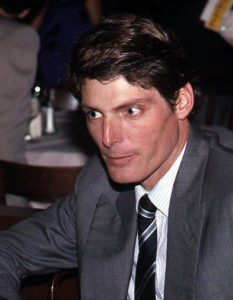 On this day in 2004, actor Christopher Reeved died from sepsis, a complication of paralysis, in Mount Kisco, New York at the age of 52. Born Christopher D’Olier Reeve on September 25, 1952 in New York City. Perhaps best known for his motion picture portrayal of the classic DC comic book superhero Superman, beginning with the acclaimed Superman (1978), for which he won a BAFTA Award.
On this day in 2004, actor Christopher Reeved died from sepsis, a complication of paralysis, in Mount Kisco, New York at the age of 52. Born Christopher D’Olier Reeve on September 25, 1952 in New York City. Perhaps best known for his motion picture portrayal of the classic DC comic book superhero Superman, beginning with the acclaimed Superman (1978), for which he won a BAFTA Award.
Reeve appeared in other critically acclaimed films such as The Bostonians (1984), Street Smart (1987) and The Remains of the Day (1993). He received a Screen Actors Guild Award and a Golden Globe Award nomination for his performance in the television remake of Rear Window (1998).
On May 27, 1995, Reeve was left quadriplegic after being thrown from a horse during an equestrian competition in Culpeper, Virginia. He used a wheelchair and needed a portable ventilator to breathe for the rest of his life. He lobbied on behalf of people with spinal cord injuries and for human embryonic stem cell research, founding the Christopher Reeve Foundation and co-founding the Reeve-Irvine Research Center.
The Final Footprint
His remains were cremated at Ferncliff Cemetery. A memorial service for Reeve was held at the Unitarian Church in Westport, Connecticut. John Lennon and Nelson Rockefeller were cremated at Ferncliff.
#RIP #OTD in 2010 singer (“Cry to Me”, “If You Need Me”, “Got to Get You Off My Mind”) a founding fathers of soul music, Solomon Burke died; pulmonary embolism; Amsterdam Schiphol Airport aged 70. Forest Lawn Memorial Park in the Hollywood Hills
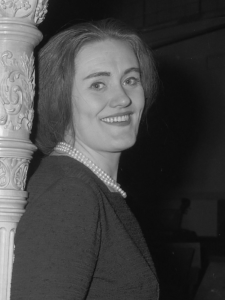 On this day in 2010, dramatic coloratura soprano Joan Sutherland died from heart failure at her home at Les Avants in Switzerland, age 83. Born Joan Alston Sutherland on 7 November 1926 in Sydney, Australia. Primarily noted for her contribution to the renaissance of the bel canto repertoire from the late 1950s through to the 1980s.
On this day in 2010, dramatic coloratura soprano Joan Sutherland died from heart failure at her home at Les Avants in Switzerland, age 83. Born Joan Alston Sutherland on 7 November 1926 in Sydney, Australia. Primarily noted for her contribution to the renaissance of the bel canto repertoire from the late 1950s through to the 1980s.
She possessed a voice combining extraordinary agility, accurate intonation, pinpoint staccatos, a trill and a tremendous upper register
Sutherland was the first Australian to win a Grammy Award, for Best Classical Performance – Vocal Soloist (with or without orchestra) in 1962.
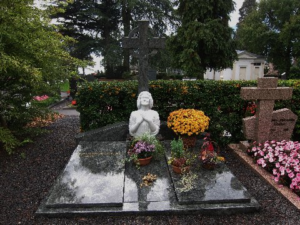 The Final Footprint
The Final Footprint
Sutherland requested a small, private funeral service. Her funeral was held on 14 October and Opera Australia planned a tribute to her. Artistic director of Opera Australia, Lyndon Terracini, said “We won’t see her like again. She had a phenomenal range, size and quality of voice. We simply don’t hear that any more.”
A State Memorial Service on 9 November 2010, arranged by Opera Australia, was held at the Sydney Opera House. The service was broadcast live by both ABC1 television and ABC Classic FM (radio) and streamed globally by ABC News 24. Further memorial services were held in Westminster Abbey on 15 February 2011, and in New York City on 24 May 2011, which was hosted by Marilyn Horne.
Cimetière de Clarens-Montreux, Avenue Eugène-Rambert, Montreux, District de la Riviera-Pays-d’Enhaut, Vaud, 1820 Switzerland. Another notable final footprint at Clarens-Montreux is that of Vladimir Nabokov.
Have you planned yours yet?
Follow TFF on twitter @RIPTFF



